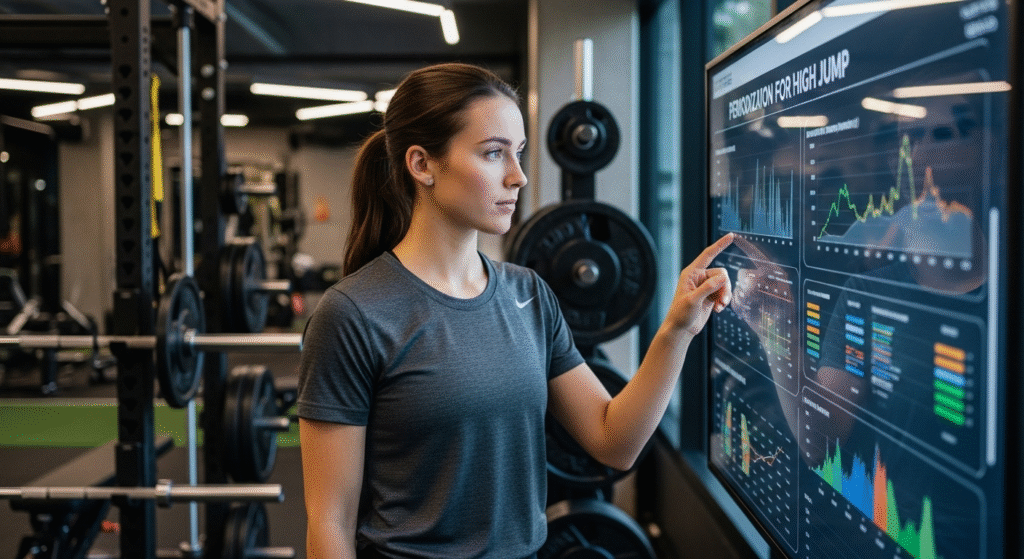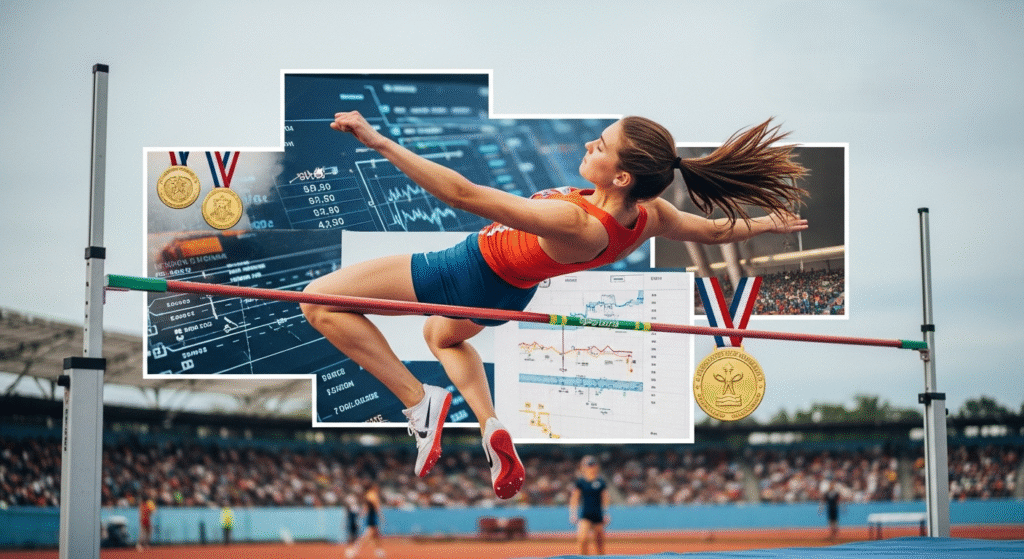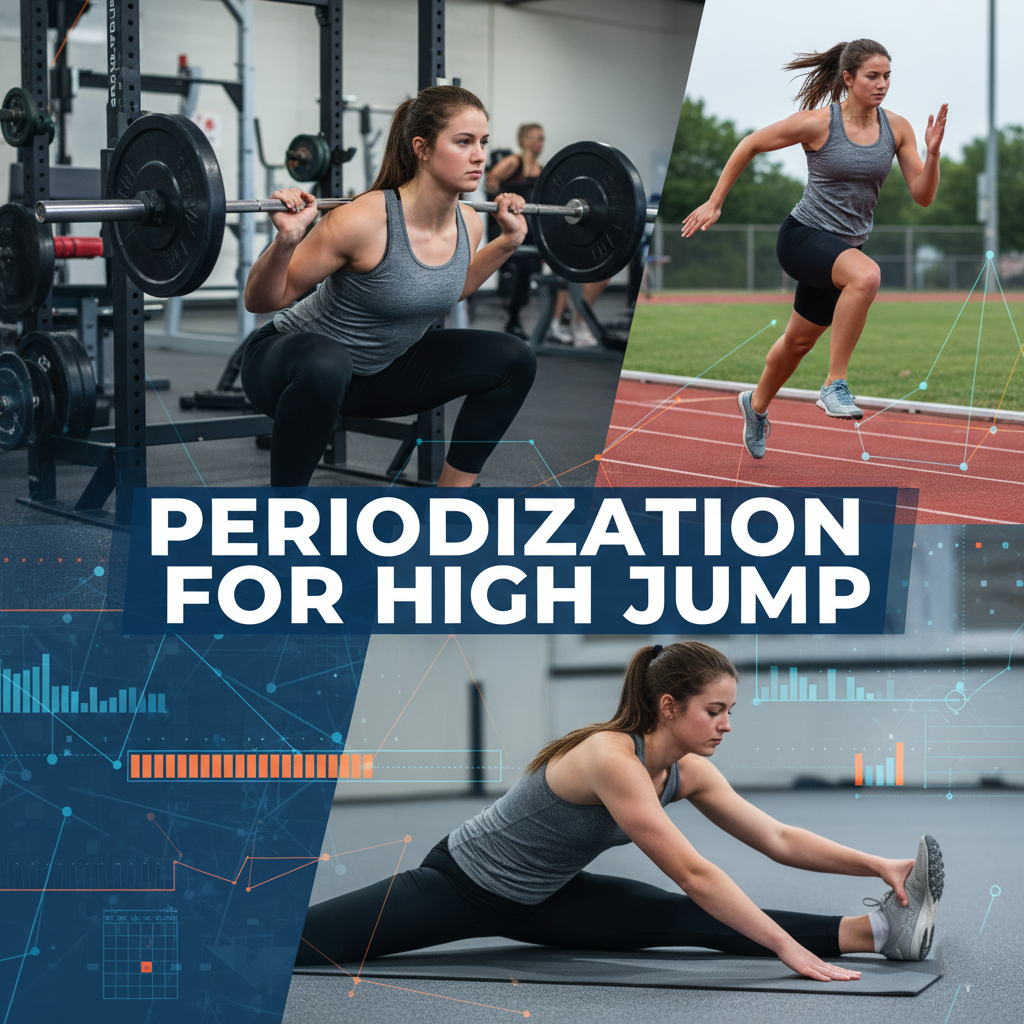Periodization for High Jump: Introduction
Achieving peak performance in the high jump requires more than raw talent; it demands a meticulously structured training plan. Periodization, the systematic planning of athletic training, plays a crucial role in optimizing strength, power, and overall performance. This article explores the art of periodization in high jump strength training, offering expert strategies to design effective training cycles, enhance athletic development, and reach competitive excellence.
High jump athletes face unique challenges that require specialized strength training approaches. The explosive power needed for takeoff, the body control required during the flight phase, and the technical precision demanded at the bar all necessitate a carefully balanced training regimen. Through effective periodization, jumpers can systematically develop these attributes while minimizing injury risk and maximizing performance gains when it matters most – during competition season.
Whether you’re a coach working with promising jumpers or an athlete looking to elevate your performance, understanding how to structure your high jump strength training through periodization principles will provide the framework for consistent improvement and competitive success.
Periodization for High Jump: Understanding the Fundamentals of Periodization
Periodization represents the cornerstone of effective athletic training, particularly for technical events like the high jump. At its core, periodization is a systematic approach to organizing training into distinct phases, each with specific objectives that build upon one another to produce peak performance at targeted times.
The concept of periodization wasn’t created overnight. It evolved from Soviet sports science in the mid-20th century, where researchers like Dr. Leo Matveyev observed that athletes couldn’t maintain peak condition year-round. Instead, they needed structured cycles of varying intensity and focus to optimize performance for key competitions while avoiding burnout and plateaus.
For high jumpers, periodization serves multiple crucial purposes. It allows for the sequential development of different performance attributes – from building a foundation of general strength to enhancing specific power and refining technical skills. This progressive approach helps jumpers avoid the common pitfall of trying to improve everything simultaneously, which often leads to suboptimal gains and increased injury risk.
Three primary models of periodization have emerged over time, each with distinctive applications for high jump training:
Linear periodization follows a straightforward progression from high-volume, low-intensity training to low-volume, high-intensity work as competition approaches. For high jumpers, this might mean beginning with general strength exercises at higher repetitions, then gradually shifting toward more explosive, jump-specific movements at maximal intensity.
Undulating periodization involves more frequent variations in training volume and intensity, often changing on a weekly or even daily basis. This approach can be particularly effective for high jumpers who need to maintain specific attributes throughout a season while still making overall progress.
Block periodization, increasingly popular among elite athletes, concentrates on developing specific qualities in focused blocks of 2-4 weeks. A high jumper might dedicate one block to maximal strength, another to explosive power, and yet another to competition-specific technical work.
Research published in the Journal of Strength and Conditioning Research demonstrates that periodized training produces superior strength gains compared to non-periodized approaches. For high jumpers, these strength improvements translate directly to enhanced takeoff power and improved performance.
- Definition and purpose of periodization in athletic training.
- Different models of periodization: linear, undulating, and block.
- Benefits of structured training phases for high jump athletes.

Periodization for High Jump: Designing Training Cycles for Optimal Performance
Creating an effective periodization plan for high jump training requires thinking in multiple time scales simultaneously. These nested cycles – macro, meso, and micro – each serve distinct purposes while contributing to the athlete’s overall development.
The macrocycle represents the broadest view of training, typically spanning an entire year or season. For high jumpers, the macrocycle often aligns with the competitive calendar, which might include indoor and outdoor seasons with distinct peak periods. Within this annual plan, the training year is divided into phases with different emphases: general preparation, specific preparation, competition, and transition (active recovery).
Mesocycles break the macrocycle into manageable blocks of 3-6 weeks, each with a specific training focus. A high jumper’s mesocycles might progress from general strength development to specific power training, then to competition-specific preparation. For example, a mesocycle focused on developing takeoff power might include progressive plyometric training combined with complementary strength work.
At the most detailed level, microcycles represent weekly training plans that balance workload, intensity, and recovery. A typical high jump microcycle might include 2-3 strength training sessions, 1-2 technical sessions, and appropriate recovery days. The art of microcycle design lies in balancing stimulus and recovery to promote adaptation without overtraining.
Setting appropriate short-term and long-term goals provides the framework for effective periodization. Short-term goals might focus on process metrics like achieving specific strength benchmarks or technical improvements, while long-term goals typically center on competition performance. For instance, a high jumper might target a 10% increase in squat strength during a strength-focused mesocycle (short-term), while aiming to clear a specific height at the national championships (long-term).
Flexibility remains essential in periodization planning. Competition schedules change, injuries occur, and progress happens at different rates than anticipated. Successful coaches and athletes continually assess and adjust their training plans based on real-world feedback. This might mean extending a strength phase if benchmarks haven’t been met, or accelerating into more specific work if progress exceeds expectations.
A practical approach to periodization for high jumpers might include a preparatory phase focused on building work capacity and general strength, a specific preparation phase emphasizing jumping power and technique, a pre-competition phase integrating all elements at increasing intensities, and finally, a competition phase maintaining capabilities while peaking for important meets.
- Breaking down the training year into macro, meso, and micro cycles.
- Setting short-term and long-term performance goals.
- Adapting training plans based on competition schedules and individual progress.

Periodization for High Jump: Balancing Strength and Power Development
High jump performance demands a unique balance of strength and power attributes. While absolute strength provides the foundation for explosive movements, it’s the rate of force development – how quickly that strength can be applied – that ultimately determines takeoff success. Effective high jump periodization carefully calibrates the development of both qualities throughout the training year.
The strength foundation for high jumpers begins with fundamental compound movements that develop total-body strength and coordination. Squats stand as perhaps the most essential strength exercise, developing the quadriceps, glutes, and core stability necessary for powerful takeoffs. Front squats particularly emphasize the quadriceps and upright posture relevant to jumping mechanics. Deadlifts complement squats by strengthening the posterior chain, enhancing the critical hip extension force needed during takeoff. For upper body development, pull-ups and rows build the back strength necessary for effective arm action during the approach and takeoff phases.
As training progresses toward more specific preparation, power development takes center stage. Plyometric exercises become increasingly important, directly enhancing the stretch-shortening cycle crucial to jumping performance. Box jumps, depth jumps, and bounding exercises teach the neuromuscular system to rapidly apply force – exactly what’s needed at takeoff. Olympic lifting derivatives like power cleans and snatches develop explosive triple extension (simultaneous extension at the ankle, knee, and hip) that mirrors the jumping action.
Unilateral exercises deserve special attention in high jump training, as the event ultimately relies on single-leg takeoff power. Split squats, single-leg Romanian deadlifts, and lunge variations build asymmetrical strength and stability. More advanced athletes can incorporate single-leg plyometrics like alternate leg bounding and single-leg depth jumps to develop specific power.
Periodization allows coaches and athletes to systematically vary the emphasis between strength and power throughout the training year. Early preparatory phases typically emphasize higher volume strength training with moderate loads (70-80% of one-rep maximum) to build muscle mass and foundational strength. As competition approaches, training shifts toward lower volume but higher intensity strength work (85-95% of maximum) combined with increasing plyometric volume.
The intensity-volume relationship follows an inverse pattern throughout periodization: as intensity increases, volume must decrease to allow proper recovery and adaptation. During a strength-focused mesocycle, a high jumper might perform 4 sets of 8 repetitions in the squat at 75% of maximum. Later, during a power-focused mesocycle, this might shift to 3 sets of 3 repetitions at 90%, followed by plyometric work.
Throughout this progression, exercise selection becomes increasingly specific to high jump demands. General strength exercises gradually give way to movements that more closely resemble the biomechanics and energy systems of competitive jumping.
- Essential strength exercises for high jumpers, such as squats and deadlifts.
- Power-focused workouts like plyometrics and Olympic lifts.
- Periodically adjusting training intensity and volume to prioritize different attributes.

Periodization for High Jump: Conclusion
Mastering periodization in high jump strength training is pivotal for athletes aiming to reach their peak performance. By understanding the fundamentals of periodization, designing structured training cycles, balancing strength and power development, incorporating essential rest phases, and diligently monitoring progress, high jumpers can optimize their training and achieve competitive excellence. Embrace these expert strategies to elevate your athletic development and soar to new heights in the high jump.
Periodization isn’t merely a training methodology—it’s a philosophy that recognizes athletic development as a long-term, nonlinear process requiring patience and strategic thinking. The most successful high jumpers understand that performances aren’t built in a day but through consistent application of appropriate training stimuli, followed by adequate recovery, repeated over months and years.
For coaches and athletes implementing high jump strength training periodization, remember that flexibility remains essential. The periodization framework provides structure, but the art lies in adapting this structure to individual needs, responses, and circumstances. What works for one athlete may not work for another, and what works during one season may need adjustment in the next.
As sport science continues to evolve, so too will periodization approaches. Stay curious, continue learning, and don’t hesitate to integrate new evidence-based methods into your periodized training plan. The most effective coaches and athletes maintain fundamentally sound principles while remaining open to innovation.
Ultimately, effective periodization transforms high jump training from a collection of workouts into a coherent journey toward athletic excellence. By applying the principles outlined in this article, you create not just stronger jumpers, but more resilient, confident, and technically proficient athletes capable of clearing new heights when it matters most.
Coach Otto is a certified track and field coach with over 15 years of experience working with high jumpers at high school, collegiate, and elite levels.

